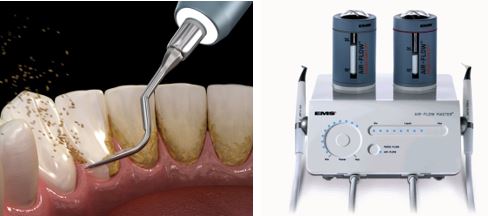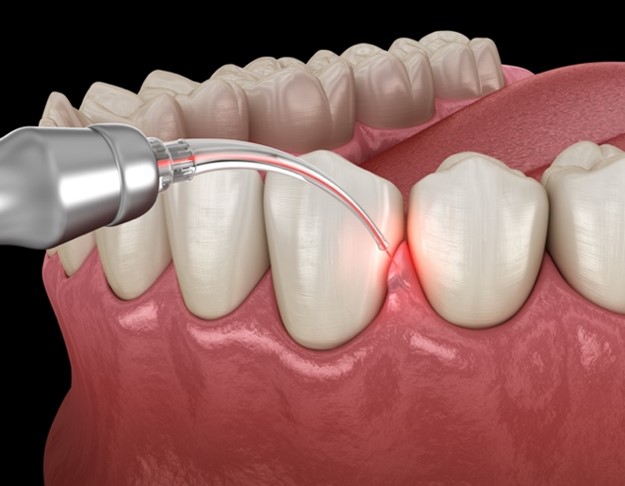Periodontal Diagnosis and Treatment
The first step in treating gum disease is to diagnose the problem. This will usually be done by taking a thorough medical history and performing a physical examination. During this, your dentist will examine your mouth to detect any signs of gum disease. They will also examine the areas where your gums meet your teeth. Your dentist will look at the inside surfaces of your gums to see if any tissue is red, has been pulled away from the teeth, or appears inflamed. The dentist may also take x-rays of your jaw to examine your teeth and bone condition.
Usually, the dental tool, known as a periodontal probe, is used to test the gum line and determine if a pocket of infection is present. The pocket depth varies from site to site and person to person. It is usually between 1 and 3 mm. A bleeding pocket more than 4 mm deep means you have periodontitis.

Please see above, the initial gum disease will be treated by hygienist using ultra, and then the patient was treated by composite bonding.
Treatments for Gum Disease
The treatment depends upon the seriousness of your case. Periodontal disease has two stages. Stage one is when you experience bleeding gums, halitosis, tenderness, and pain. This is the earliest stage of gum disease. The 2nd stage is when your gum starts to recede, and teeth get more sensitive.
Gum disease treatment initiates with a non-surgical tooth surface debridement and surgical. After three months, your periodontist undertakes a full-mouth periodontal assessment. In some cases, further improvement in pocket depths is required. Hence a conventional or regenerative surgical approach is required.
There are two main types of treatment for gum disease:
- Non-surgical gum treatments
- Surgical gum treatments
Let’s look at both non-surgical and surgical gum treatment options:
Non-Surgical Treatments
The non-surgical procedure includes Professional cleaning, root-surface debridement and polishing.

Please see above, the initial gum disease will be treated by hygienist using ultra, and then the patient was treated by composite bonding.
Scaling and root planning: It is a deep-cleaning process where the dentist uses a special tool called an ultrasonic scaler to remove any calculus or tartar present in the gum. Root planning involves removing the soft tissue from the teeth’ roots and smoothing the tooth’s rough surface. Smoothing helps to prevent bacteria from adhering to the tooth surface.
Professional cleaning: Dental hygienists perform this procedure by debriding the teeth surface with an electric polisher and/or airflow device. After your professional teeth cleaning, she will apply fluoride to the teeth. You may also benefit from using mouthwashes containing antiseptic agents such as Triclosan™ and chlorhexidine.
Surgical Treatments
Surgical treatments are performed under local anaesthesia and in more severe cases of gum disease. They are used If the gum disease has progressed to the extent that the bone around the tooth is affected.
Surgical Treatments Include:
Flap Surgery: This is performed by lifting the gum tissues to reach the pockets between the teeth and gums to remove plaque and infected areas of the gingiva. For this, the dentist will take an incision into the gum line.
Grafting: The dentist removes a portion of the gums and surrounding tissue to expose the bone beneath. Inflamed tissue and bone are removed, and healthy gums are grafted to the area. Since periodontitis often causes bone loss, the underlying bone may need to be reshaped before the gum tissue is reattached.
Gum Tissue Regeneration: This promotes the growth of new bone in areas where it has been destroyed. When your dentist uses this approach, he’ll place a special fabric between the existing bone and your tooth. This material protects the wounded area and keeps tissue out to allow the bone to heal.
When you are being treated for gum disease, it is essential to have regular check-ups to avoid serious health problems later on.
Laser Therapy
Another option for treatment is the laser. This is a highly effective method of removing plaque and tartar from your teeth.
How Laser-assisted Periodontal Therapy Works?

Laser therapy is a medical procedure that uses a special beam of light. Laser therapy works by exposing the affected area to laser beams. These beams pass through your gums and into the periodontal pocket, Destroying the bacteria and will break the plaque and tartar away. The laser does not just remove plaque and tartar. It also removes any damaged tissue and prevents infection from returning. Another tool smooths the rough spots on your tooth above and below the gum line.
If you want to ensure your teeth and gums are in the best shape possible, or if you wish to have regular check-ups, book an appointment for a routine check-up with one of our top periodontist dentists to ensure your teeth and gums stay in the best shape possible.
London Specialist Dentists is conveniently located in Knightsbridge, Central London. Perfect for the gum disease and periodontal treatment patients from London, Kensington, High Street Kensington, Knightsbridge, Belgravia, Fulham, Westminster and Chelsea.

